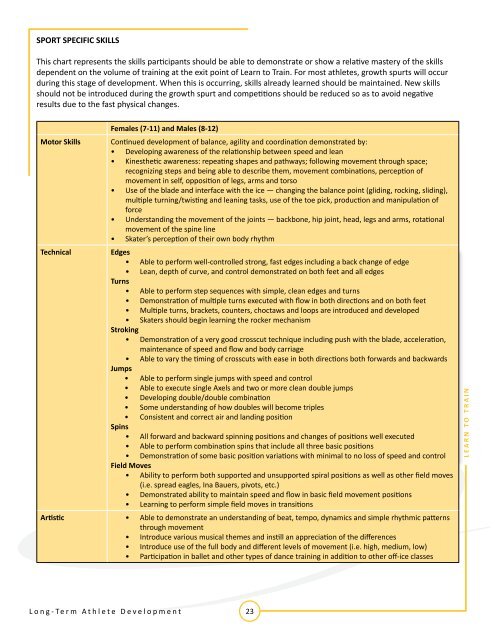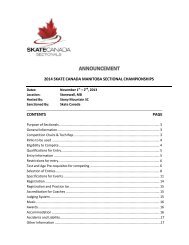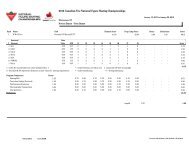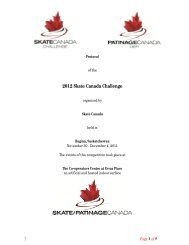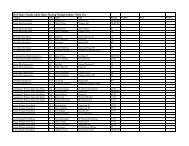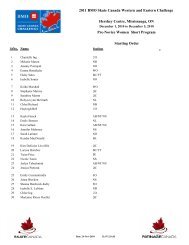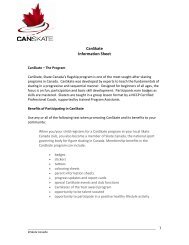LONG-TERM ATHLETE DEVELOPMENT - Skate Canada
LONG-TERM ATHLETE DEVELOPMENT - Skate Canada
LONG-TERM ATHLETE DEVELOPMENT - Skate Canada
You also want an ePaper? Increase the reach of your titles
YUMPU automatically turns print PDFs into web optimized ePapers that Google loves.
SPORT SPECIFIC SKILLS<br />
L o n g - Te r m A t h l e t e D e v e l o p m e n t<br />
23<br />
865 Sheord Road, Ottawa, Ontario K1J 1H9<br />
This chart represents the skills participants should be able to demonstrate or show a relative mastery of the skills<br />
Phone 613.747.1007 I Toll Free 1.888.747.2372 I Fax 613.748.5718 I Toll Free Fax 1.877.211.2372<br />
dependent on the volume of training at the exit point of Learn to Train. For most athletes, growth spurts will occur<br />
during this stage of development. When this is occurring, skills already learned should be maintained. New skills<br />
should not be introduced during the growth spurt and competitions should be reduced so as to avoid negative<br />
results due to the fast physical changes.<br />
Motor Skills<br />
Females (7-11) and Males (8-12)<br />
Continued development of balance, agility and coordination demonstrated by:<br />
• Developing awareness of the relationship between speed and lean<br />
• Kinesthetic awareness: repeating shapes and pathways; following movement through space;<br />
recognizing steps and being able to describe them, movement combinations, perception of<br />
movement in self, opposition of legs, arms and torso<br />
• Use of the blade and interface with the ice — changing the balance point (gliding, rocking, sliding),<br />
multiple turning/twisting and leaning tasks, use of the toe pick, production and manipulation of<br />
force<br />
• Understanding the movement of the joints — backbone, hip joint, head, legs and arms, rotational<br />
movement of the spine line<br />
• <strong>Skate</strong>r’s perception of their own body rhythm<br />
Technical Edges<br />
• Able to perform well-controlled strong, fast edges including a back change of edge<br />
•<br />
Turns<br />
Lean, depth of curve, and control demonstrated on both feet and all edges<br />
• Able to perform step sequences with simple, clean edges and turns<br />
• Demonstration of multiple turns executed with flow in both directions and on both feet<br />
• Multiple turns, brackets, counters, choctaws and loops are introduced and developed<br />
•<br />
Stroking<br />
<strong>Skate</strong>rs should begin learning the rocker mechanism<br />
• Demonstration of a very good crosscut technique including push with the blade, acceleration,<br />
maintenance of speed and flow and body carriage<br />
•<br />
Jumps<br />
Able to vary the timing of crosscuts with ease in both directions both forwards and backwards<br />
• Able to perform single jumps with speed and control<br />
• Able to execute single Axels and two or more clean double jumps<br />
• Developing double/double combination<br />
• Some understanding of how doubles will become triples<br />
•<br />
Spins<br />
Consistent and correct air and landing position<br />
• All forward and backward spinning positions and changes of positions well executed<br />
• Able to perform combination spins that include all three basic positions<br />
• Demonstration of some basic position variations with minimal to no loss of speed and control<br />
Field Moves<br />
• Ability to perform both supported and unsupported spiral positions as well as other field moves<br />
(i.e. spread eagles, Ina Bauers, pivots, etc.)<br />
• Demonstrated ability to maintain speed and flow in basic field movement positions<br />
• Learning to perform simple field moves in transitions<br />
Artistic • Able to demonstrate an understanding of beat, tempo, dynamics and simple rhythmic patterns<br />
through movement<br />
• Introduce various musical themes and instill an appreciation of the differences<br />
• Introduce use of the full body and different levels of movement (i.e. high, medium, low)<br />
• Participation in ballet and other types of dance training in addition to other off-ice classes<br />
L E A R N T O T R A I N


